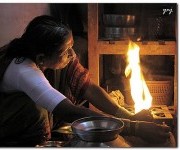Billions across the world still depend on wood or dung fires for cooking.Photo: Yogendra JoshiWe usually speak of “alternative energy sources” as positives. Across the developing world, however, these “alternatives” take the forms of dung and wood for cooking, candles and kerosene for lighting. Governments have done an absolutely dismal job of rolling out access to modern energy.
But there is, as is so often the case, some good news buried here: Cleantech off-grid solutions are now competitive. Just as many in developing countries skipped landlines and went right to mobile phones, we may soon see the billions who now rely on traditional fuels skip coal and oil and transition directly into sustainable energy sources — which will be an enormous help to the global environment.
The International Energy Agency suggests that 1.4 billion people worldwide still lack access to electricity in their homes. These people are overwhelmingly in poor countries, and most live in rural areas. That means, for example, that only one in seven of the rural population of sub-Saharan Africa has electrical access. Even many of those with access to electricity still have to depend on sources like wood or dung for cooking — adding up to 2.7 billion people worldwide who use “traditional” or “biomass” sources. Wood and dung account for 10.2 percent of the global energy supply.
The limited reach of modern energy sources is grim news for the poor people left using alternatives. India alone sees 2.5 million cases of severe burns each year caused by overturned kerosene lamps. And the World Health Organization labels wood stoves “the killer in the kitchen” — the indoor air pollution they produce is responsible for 1.5 million deaths a year.
Beyond their health impacts, fuels like wood, candles, kerosene, and dung are a very expensive source of power. That’s because they are grossly inefficient at turning fuel into usable energy. For each joule of energy a candle turns into visible light, 2,500 joules are wasted (largely as heat). The same number for a traditional incandescent light bulb is one joule to light for every 50 wasted. (For an LED it’s about one to seven.) Traditional wood stoves convert fuel to cooking heat with one-third or less of the efficiency [PDF] of gas stoves. As a result, poor people often can’t afford adequate lighting, cooking, or heating — when the sun goes down, their houses simply get cold and dark.
 Why are so many poor people reliant on heating and lighting technologies that date back centuries or even millenniums? In part because governments in the developing world have focused on providing subsidized electricity to an elite few rather than rolling out access to the many. Survey evidence from a few years ago suggested only 60 percent of costs are met by revenues in the electricity sector of the average developing country. About a third [PDF] of electricity companies in Africa and South Asia don’t even have the resources to conduct basic operations and maintenance — let alone roll out access to new customers.
Why are so many poor people reliant on heating and lighting technologies that date back centuries or even millenniums? In part because governments in the developing world have focused on providing subsidized electricity to an elite few rather than rolling out access to the many. Survey evidence from a few years ago suggested only 60 percent of costs are met by revenues in the electricity sector of the average developing country. About a third [PDF] of electricity companies in Africa and South Asia don’t even have the resources to conduct basic operations and maintenance — let alone roll out access to new customers.
Beyond the fact that poor people just have less money to spend in general (that’s what it means to be poor), the greater cost of their energy sources is one reason why energy consumption is a lot lower in poor countries than in rich ones. World Bank data suggest that, every year, people in low-income countries (with average GDP per head below about $1,000) use energy equivalent to that produced by burning 803 pounds of oil. Those in middle-income countries use up nearly four times as much — the equivalent of 2,765 pounds, or a little more than a metric ton. The same figure for high-income countries is more than five tons.
From an environmental perspective, of course, it is probably a good thing that poor people use less energy. If they were using candles to light their houses anywhere near as brightly as rich people do using light bulbs, they’d be consuming 50 times the energy to do so — and that would mean a lot more carbon dioxide and other greenhouse gases in the atmosphere (alongside a candle collection that would do shame to Methuselah’s birthday party).
Though it would be wonderful for poor people if they were all connected to the electricity grid, it could be devastating news for the global environment. According to World Bank data, the limited electricity sectors of low-income countries currently rely for nearly half of their power on hydroelectric sources, compared with about 7 percent from coal. If they were producing a lot more electricity, doubtless most of that power would come from fossil fuels. In middle income countries, for example, it is coal that accounts for nearly half of all electricity production, with hydro providing one-fifth. Fossil fuels as a whole account for only 30 percent of low income energy consumption compared with more than 80 percent in middle-income countries.
For all of the misery suffered by generations without electricity, at least the world has dodged one bullet — a huge legacy stock of dirty power plants in low-income countries belching out CO2 for the rest of their 30-year lives. But that silver lining on the cloud of global energy poverty may be about to fray, because the cloud itself is evaporating. Many of the poorest of the world’s people are at last becoming richer — and they are going to demand more energy as a result.
Xavier Sala-i-Martin and Maxim Pinkovskiy [PDF] of Columbia University and the Massachusetts Institute of Technology estimate that Africa will halve the number of people living on $1.25 or less — the global definition for absolute poverty — between 1990 and 2017. And the number of countries worldwide classified as low-income by the World Bank has fallen from 63 in 2000 to 35 this year. We’ve seen those are the countries that largely rely on hydro power rather than fossil fuels (think the Nam Theun dam in Laos or the Inga Dams in the Democratic Republic of Congo). And middle-income countries consume four times the energy. Absent new technologies that produce cleaner power for all of these richer countries, the global environment will be in even more dire straits than it is already.
Mercifully, just as the developing world is getting a lot more energy-hungry, methods to get that power from off-grid, energy-efficie
nt, and environmentally sustainable sources are coming to the market. For example, solar lanterns — which use solar cells to charge a battery that powers an LED at night — are now available for less than $20. The payback period for buying that solar lantern rather than a cheaper kerosene model and the fuel to power it will fall from seven months today to below two months in 2015. And whole solar panels cost 40 percent of what they did a mere two years ago. In India, a panel costs about $300, the cost of a year’s supply of kerosene for a lamp — but the panel provides sufficient electricity for a battery to power a number of considerably brighter lights. More broadly, developing countries are spending more than rich countries on new renewable capacity — $72 billion in 2010. David Wheeler at the Center for Global Development suggests India plans to generate 15 percent of its energy from renewable sources by 2020, mostly from solar. The Intergovernmental Panel on Climate Change reckons that renewables could be delivering as much as 80 percent of the world’s power by midcentury.
If we do manage this energy transformation, the world will have achieved a stunning combination of victories. First, over the energy poverty and poor health of those billions relying on dangerous, inefficient traditional sources, and, second, over the greenhouse gas excess of those consuming power from burning stuff — be it dung, wood, coal, or oil. Making this conversion happen surely seems worth the odd carbon tax or renewable subsidy.



